- Connecting audio
- Audio PC
- Raspberry & Co
- All in Ones
- Bluetooth
- Chromecast
- Streaming audio player
- Music server
- USB Audio
- Real-time audio over IP
- FireWire DAC
- Multi-channel DAC
- NAS
- Remote control
- Vinyl rippers
- Acoustic materials
- Active crossover
- Active speakers
- Single driver speakers
- Invisible speakers
- Sound card
- Digital room correction
- Headphone
- Portable media players
Active speakers
Our hearing covers a very wide range. We can hear anything between 30 and 20.000 Hz (when young).
To cover the entire range is a very demanding task for a loudspeaker.
It needs to move a lot of air to reproduce the low bass so it must be big and becomes heavy.
It needs to be very fast to vibrate at 20.000 Hz so must be small and light at the same time too.
This is so demanding that the task is split.
The bass is handled by a woofer, the treble by a tweeter.
Feeding the treble to the bass probably results in some distortion, feeding the bass to the tweeter simple burns it.
We need a low pass filter and a high pass filter to see to it that the speakers only receive frequencies it can handle.
This is called a crossover.
Passive speakers
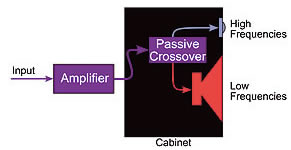 Conventional speakers have a built-in crossover.
Conventional speakers have a built-in crossover.
As all the power of the amp runs through the crossover, only simple components like capacitors, resistors and inductors (coil) can be used.
This is called a passive speaker.
Almost all speakers at the home are passive.
Active speakers
In the eighties the pro-world discovered that you can improve sound quality by removing the crossover from the power path.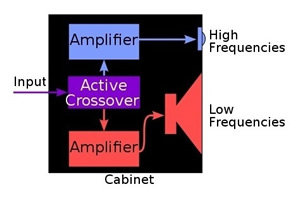
As you can't do without a crossover; it is applied on the signal before it enters the power amp.
This allows the implementation of better and steeper filters because now active components can be used instead of passive components only.
It also allows for correction of differences in phase.
This is covered in more detail here.
The obvious consequence of an active speaker is that because you connect the power amp straight to the speaker, you need an amp per speaker.
Sounds expensive but today electronic components are cheap.
That beautifully machined aluminum box containing the electronics is probably the most expensive part of an amp.
Most of the time active speakers have the amps built-in. Indeed it saves you the cost of the enclosure and keep the signal path short.
Almost all studio monitors are active speakers.
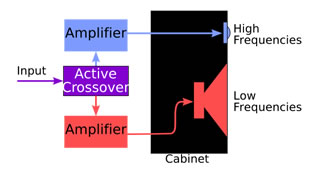
Some models are simply speakers without a passive crossover inside.
They are supposed to be driven by an external Xover and amps.
I call them "active ready".
Powered speakers
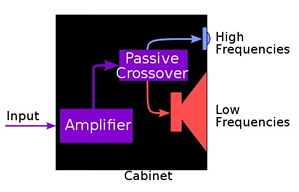
Not all speakers with built-in amplification are active.
A built-in amp can be used to drive the speakers in the conventional way using passive crossovers. This is called a powered speaker.
A lot of speakers targeting the desktop are built this way.
This is a matter of space and cost saving.
Active crossover
An Active crossover can be implemented using the traditional electronic components but it can also be done by using a processor.
This is covered in more detail here.
Active speakers are rare
Well, not really. If you look at the pro-world, a lot of studio monitors
are active.
But active systems targeting home audio are a bit hard to find.
I wonder what the differences between the pro-monitors and the domesticated versions really are; choice in veneer?
In 2012 a couple of brands released active speakers obvious targeted at the home.
Most of them small desktop models featuring a wireless connection.
It looks like this is becoming a trend.
If I tell you there is an active system
- Digital input over the network
- AD converter for analog input
- Equalization in DSP
- 4th-order Linkwitz-Riley crossover in DSP
- 4 DAC’s + 1 for the woofer
- 4 class D amplifiers
- Headphone amp
- 2 woofers + 2 tweeters
You don’t expect it to cost $300 don’t you?
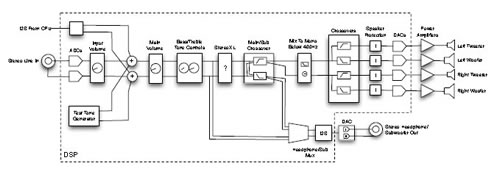
A German forum dedicated to active speakers.
An extensive list of manufacturers.
Master List of Speaker Companies - Audio Science Review
A list of active speakers (no longer maintained)



